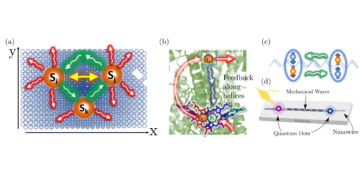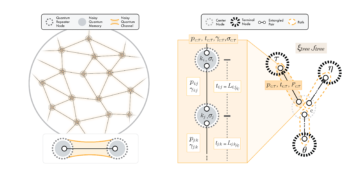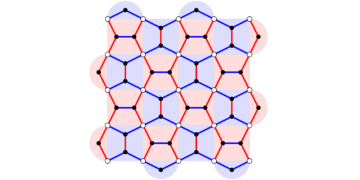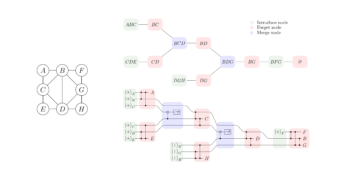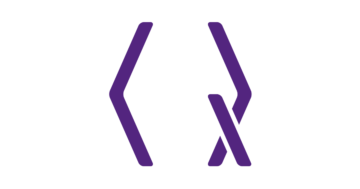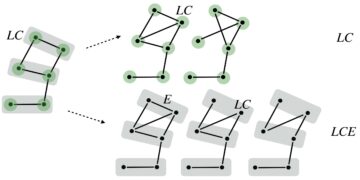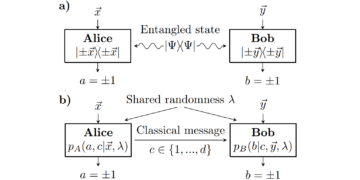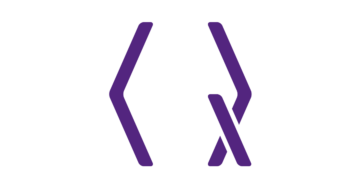1Sandia National Laboratories, Livermore, CA 94550, USA
2Quantum Performance Laboratory, Sandia National Laboratories, Albuquerque, NM 87185, USA and Livermore, CA 94550, USA
Find this paper interesting or want to discuss? Scite or leave a comment on SciRate.
Abstract
As the width and depth of quantum circuits implemented by state-of-the-art quantum processors rapidly increase, circuit analysis and assessment via classical simulation are becoming unfeasible. It is crucial, therefore, to develop new methods to identify significant error sources in large and complex quantum circuits. In this work, we present a technique that pinpoints the sections of a quantum circuit that affect the circuit output the most and thus helps to identify the most significant sources of error. The technique requires no classical verification of the circuit output and is thus a scalable tool for debugging large quantum programs in the form of circuits. We demonstrate the practicality and efficacy of the proposed technique by applying it to example algorithmic circuits implemented on IBM quantum machines.
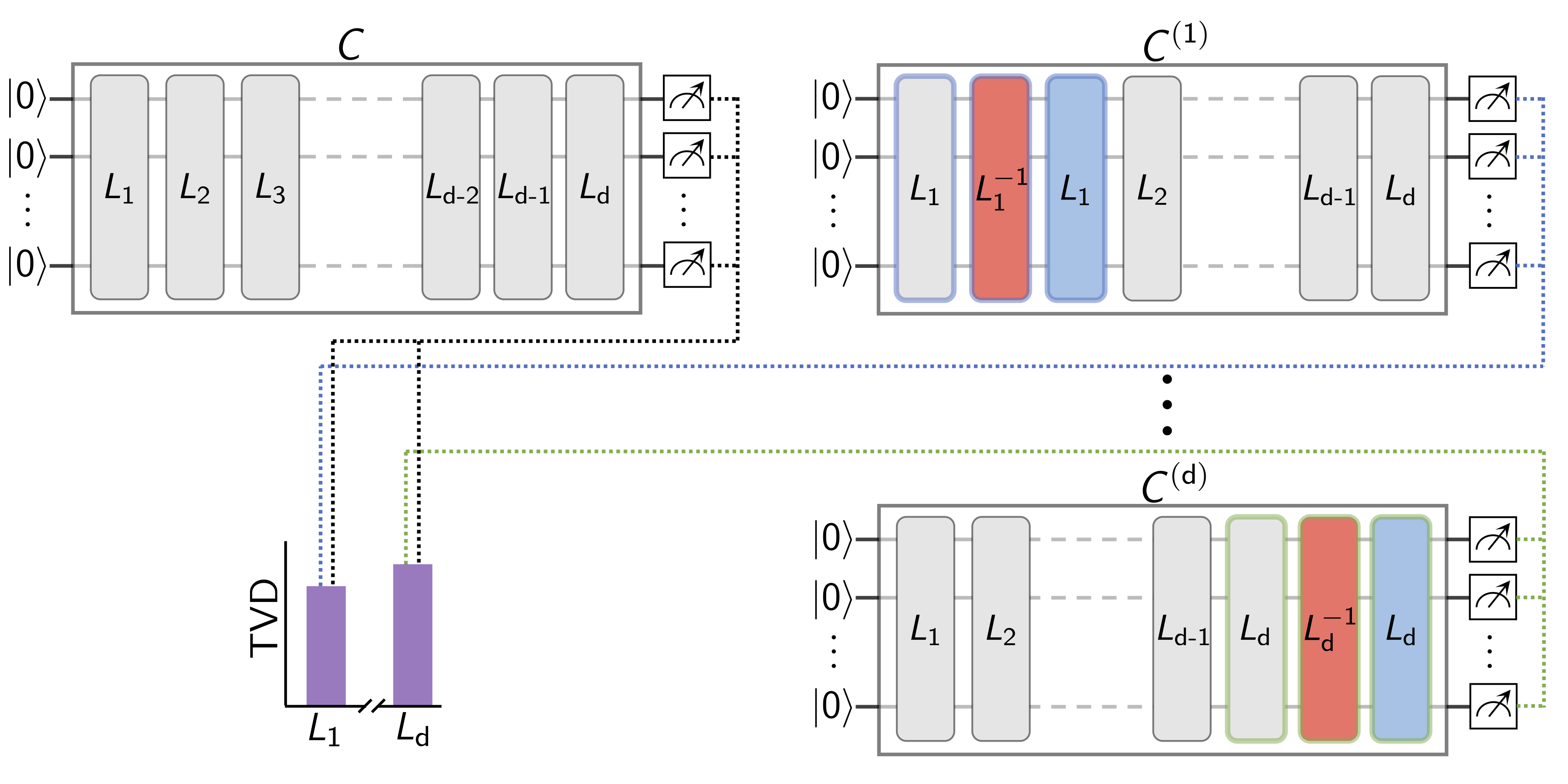
Featured image: The $textit{local inversion}$ technique shows the extent to which the errors in each of the $d$ layers ($L$) of a circuit $C$ perturb the output probability distribution. That is done by calculating the total variation distances (TVDs) between the output probability distribution of the circuit $C$ and the probability distributions of each of the $d$ circuits $C^{(i)}$. In each $C^{(i)}$ circuit, we invert the $i$-th layer and repeat it such that, in the absence of error on $L_i$, $L_i L_i^{-1} L_i=L_i$. The relative magnitude of the TVD between the probability distributions of $C$ and $C^{(i)}$ is proportional to the degree the circuit outcome is perturbed by the errors in layer $L_i$.
Popular summary
► BibTeX data
► References
[1] IBM Unveils breakthrough 127-qubit quantum processor, https://newsroom.ibm.com/2021-11-16-IBM-Unveils-Breakthrough-127-Qubit-Quantum-Processor.
https://newsroom.ibm.com/2021-11-16-IBM-Unveils-Breakthrough-127-Qubit-Quantum-Processor
[2] A preview of Bristlecone, Google’s new quantum processor, https://ai.googleblog.com/2018/03/a-preview-of-bristlecone-googles-new.html.
https://ai.googleblog.com/2018/03/a-preview-of-bristlecone-googles-new.html
[3] Philip Ball, Physicists in China challenge Google’s ‘quantum advantage’, Nature 588, 380–380 (2020).
https://doi.org/10.1038/d41586-020-03434-7
[4] Rigetti, what we build, https://www.rigetti.com/what-we-build.
https://www.rigetti.com/what-we-build
[5] Matthew Treinish, Jay Gambetta, et al., Qiskit/qiskit: Qiskit 0.28.0 (2021).
https://doi.org/10.5281/zenodo.5096364
[6] Cirq Developers, Cirq (2021).
https://doi.org/10.5281/ZENODO.5182845
[7] Peter J. Karalekas et al., PyQuil: Quantum programming in Python (2020).
https://doi.org/10.5281/ZENODO.3631770
[8] Krysta Svore, Martin Roetteler, Alan Geller, Matthias Troyer, John Azariah, Christopher Granade, Bettina Heim, Vadym Kliuchnikov, Mariia Mykhailova, and Andres Paz, Q#: Enabling Scalable Quantum Computing and Development with a High-level DSL, in Proceedings of the Real World Domain Specific Languages Workshop 2018 on – RWDSL2018 (ACM Press, Vienna, Austria, 2018) pp. 1–10.
https://doi.org/10.1145/3183895.3183901
[9] John Preskill, Quantum computing in the NISQ era and beyond, Quantum 2, 79 (2018).
https://doi.org/10.22331/q-2018-08-06-79
[10] Kaveh Khodjasteh, Daniel a. Lidar, and Lorenza Viola, Arbitrarily Accurate Dynamical Control in Open Quantum Systems, Physical Review Letters 104, 090501 (2010).
https://doi.org/10.1103/PhysRevLett.104.090501
[11] Edwin Barnes, Fernando A Calderon-Vargas, Wenzheng Dong, Bikun Li, Junkai Zeng, and Fei Zhuang, Dynamically corrected gates from geometric space curves, Quantum Science and Technology 7, 023001 (2022).
https://doi.org/10.1088/2058-9565/ac4421
[12] J. True Merrill and Kenneth R. Brown, Progress in Compensating Pulse Sequences for Quantum Computation, in Quantum Information and Computation for Chemistry (John Wiley & Sons, Inc., 2014) pp. 241–294, iSSN: 00652385.
https://doi.org/10.1002/9781118742631.ch10
[13] Xin Wang, Lev S Bishop, J P Kestner, Edwin Barnes, Kai Sun, and S Das Sarma, Composite pulses for robust universal control of singlet-triplet qubits., Nature communications 3, 997 (2012), publisher: Nature Publishing Group.
https://doi.org/10.1038/ncomms2003
[14] Charles D. Hill, Robust Controlled-NOT Gates from Almost Any Interaction, Physical Review Letters 98, 180501 (2007), iSBN: 0031-9007; 0031-9007.
https://doi.org/10.1103/PhysRevLett.98.180501
[15] F. A. Calderon-Vargas and J. P. Kestner, Dynamically Correcting a CNOT Gate for any Systematic Logical Error, Physical Review Letters 118, 150502 (2017).
https://doi.org/10.1103/PhysRevLett.118.150502
[16] E. Knill, D. Leibfried, R. Reichle, J. Britton, R. B. Blakestad, J. D. Jost, C. Langer, R. Ozeri, S. Seidelin, and D. J. Wineland, Randomized benchmarking of quantum gates, Physical Review A 77, 10.1103/physreva.77.012307 (2008).
https://doi.org/10.1103/physreva.77.012307
[17] Easwar Magesan, J. M. Gambetta, and Joseph Emerson, Scalable and robust randomized benchmarking of quantum processes, Physical Review Letters 106, 10.1103/physrevlett.106.180504 (2011).
https://doi.org/10.1103/physrevlett.106.180504
[18] Sarah Sheldon, Lev S. Bishop, Easwar Magesan, Stefan Filipp, Jerry M. Chow, and Jay M. Gambetta, Characterizing errors on qubit operations via iterative randomized benchmarking, Physical Review A 93, 012301 (2016).
https://doi.org/10.1103/PhysRevA.93.012301
[19] Yipeng Huang and Margaret Martonosi, Statistical assertions for validating patterns and finding bugs in quantum programs, in Proceedings of the 46th International Symposium on Computer Architecture (ACM, Phoenix Arizona, 2019) pp. 541–553.
https://doi.org/10.1145/3307650.3322213
[20] Ji Liu, Gregory T. Byrd, and Huiyang Zhou, Quantum Circuits for Dynamic Runtime Assertions in Quantum Computation, in Proceedings of the Twenty-Fifth International Conference on Architectural Support for Programming Languages and Operating Systems (ACM, Lausanne Switzerland, 2020) pp. 1017–1030.
https://doi.org/10.1145/3373376.3378488
[21] Gushu Li, Li Zhou, Nengkun Yu, Yufei Ding, Mingsheng Ying, and Yuan Xie, Projection-based runtime assertions for testing and debugging Quantum programs, Proceedings of the ACM on Programming Languages 4, 1–29 (2020).
https://doi.org/10.1145/3428218
[22] Ji Liu and Huiyang Zhou, Systematic Approaches for Precise and Approximate Quantum State Runtime Assertion, in 2021 IEEE International Symposium on High-Performance Computer Architecture (HPCA) (IEEE, Seoul, Korea (South), 2021) pp. 179–193.
https://doi.org/10.1109/HPCA51647.2021.00025
[23] Tudor Giurgica-Tiron, Yousef Hindy, Ryan LaRose, Andrea Mari, and William J. Zeng, Digital zero noise extrapolation for quantum error mitigation, in 2020 IEEE International Conference on Quantum Computing and Engineering (QCE) (2020) p. 306.
https://doi.org/10.1109/QCE49297.2020.00045
[24] Alexander J. McCaskey, Zachary P. Parks, Jacek Jakowski, Shirley V. Moore, Titus D. Morris, Travis S. Humble, and Raphael C. Pooser, Quantum chemistry as a benchmark for near-term quantum computers, npj Quantum Information 5, 1 (2019).
https://doi.org/10.1038/s41534-019-0209-0
[25] Andre He, Benjamin Nachman, Wibe A. de Jong, and Christian W. Bauer, Zero-noise extrapolation for quantum-gate error mitigation with identity insertions, Physical Review A 102, 012426 (2020).
https://doi.org/10.1103/PhysRevA.102.012426
[26] Edward Farhi, Jeffrey Goldstone, and Sam Gutmann, A quantum approximate optimization algorithm, arXiv:1411.4028 (2014).
arXiv:1411.4028v1
[27] Michael A. Nielsen and Isaac L. Chuang, Quantum Computation and Quantum Information (Cambridge University Press, Cambridge, 2010).
https://doi.org/10.1017/CBO9780511976667
[28] David C. McKay, Christopher J. Wood, Sarah Sheldon, Jerry M. Chow, and Jay M. Gambetta, Efficient Z-gates for quantum computing, Physical Review A 96, 022330 (2017).
https://doi.org/10.1103/PhysRevA.96.022330
[29] pyQAOA, https://github.com/gregvw/pyQAOA.
https://github.com/gregvw/pyQAOA
[30] Robin Blume-Kohout, John King Gamble, Erik Nielsen, Kenneth Rudinger, Jonathan Mizrahi, Kevin Fortier, and Peter Maunz, Demonstration of qubit operations below a rigorous fault tolerance threshold with gate set tomography, Nature Communications 8, 1–13 (2017).
https://doi.org/10.1038/ncomms14485
[31] PyGSTi. a python implementation of Gate Set Tomography, https://www.pygsti.info/.
https://www.pygsti.info/
[32] Lukasz Cincio, Kenneth Rudinger, Mohan Sarovar, and Patrick J. Coles, Machine Learning of Noise-Resilient Quantum Circuits, PRX Quantum 2, 010324 (2021).
https://doi.org/10.1103/PRXQuantum.2.010324
[33] Kenneth Rudinger, Timothy Proctor, Dylan Langharst, Mohan Sarovar, Kevin Young, and Robin Blume-Kohout, Probing Context-Dependent Errors in Quantum Processors, Physical Review X 9, 021045 (2019).
https://doi.org/10.1103/PhysRevX.9.021045
[34] E. L. Hahn, Spin Echoes, Physical Review 80, 580–594 (1950).
https://doi.org/10.1103/PhysRev.80.580
[35] Timothy Proctor, Kenneth Rudinger, Kevin Young, Erik Nielsen, and Robin Blume-Kohout, Measuring the Capabilities of Quantum Computers, Nature Physics 18, 75 (2022).
https://doi.org/10.1038/s41567-021-01409-7
[36] When the input state is (or close to) a computational basis state, the output distribution given by QFT is close to uniform, rendering our technique inefficient as discussed in the Discussion section.
[37] Constantinos Daskalakis, Ilias Diakonikolas, and Rocco A. Servedio, Learning k-Modal Distributions via Testing, Theory of Computing 10, 535–570 (2014).
https://doi.org/10.4086/toc.2014.v010a020
[38] Kristan Temme, Sergey Bravyi, and Jay M. Gambetta, Error Mitigation for Short-Depth Quantum Circuits, Physical Review Letters 119, 180509 (2017).
https://doi.org/10.1103/PhysRevLett.119.180509
[39] Abhinav Kandala, Kristan Temme, Antonio D. Córcoles, Antonio Mezzacapo, Jerry M. Chow, and Jay M. Gambetta, Error mitigation extends the computational reach of a noisy quantum processor, Nature 567, 491–495 (2019).
https://doi.org/10.1038/s41586-019-1040-7
[40] Ewout van den Berg, Zlatko K. Minev, Abhinav Kandala, and Kristan Temme, Probabilistic error cancellation with sparse pauli-lindblad models on noisy quantum processors 10.48550/arxiv.2201.09866 (2022).
https://doi.org/10.48550/arxiv.2201.09866
[41] Tirthak Patel, Daniel Silver, and Devesh Tiwari, Charter: Identifying the most-critical gate operations in quantum circuits via amplified gate reversibility, in Proceedings of the International Conference on High Performance Computing, Networking, Storage and Analysis, SC ’22 (IEEE Press, 2022).
https://dl.acm.org/doi/abs/10.5555/3571885.3571904
[42] The vectorization of a $ktimes ell$ matrix $A$ can be represented as a linear sum $mathrm{vec}(A) = sum_{i=1}^{ell} mathbf{e}_i otimes A mathbf{e}_i$, where $mathbf{e}_i = [0,0,ldots ,1,dots ,0]^{mathrm{T}}]$ is the $i$-th canonical basis for the $ell$-dimensional space. The vectorized form of the matrix multiplication is given by $mathrm{vec}(ABC)=(C^{mathrm{T}}otimes A)mathrm{vec}(B)$, where $B$ ($C$) is an $ell times m$ ($mtimes n$) matrix.
[43] Robin Blume-Kohout, Marcus P. da Silva, Erik Nielsen, Timothy Proctor, Kenneth Rudinger, Mohan Sarovar, and Kevin Young, A Taxonomy of Small Markovian Errors, PRX Quantum 3, 020335 (2022).
https://doi.org/10.1103/PRXQuantum.3.020335
[44] Daniel Greenbaum, Introduction to Quantum Gate Set Tomography, arXiv:1509.02921 [quant-ph] (2015), arXiv: 1509.02921.
arXiv:1509.02921
[45] Jerry M. Chow, Jay M. Gambetta, A. D. Corcoles, Seth T. Merkel, John A. Smolin, Chad Rigetti, S. Poletto, George A. Keefe, Mary B. Rothwell, J. R. Rozen, Mark B. Ketchen, and M. Steffen, Universal quantum gate set approaching fault-tolerant thresholds with superconducting qubits, Physical Review Letters 109, 060501 (2012).
https://doi.org/10.1103/PhysRevLett.109.060501
[46] T. M. Cover and Joy A. Thomas, Elements of information theory, 2nd ed. (Wiley-Interscience, Hoboken, N.J, 2006).
https://onlinelibrary.wiley.com/doi/book/10.1002/047174882X
[47] Mohan Sarovar, Jun Zhang, and Lishan Zeng, Reliability of analog quantum simulation, EPJ Quantum Technology 4, 1 (2017).
https://doi.org/10.1140/epjqt/s40507-016-0054-4
[48] Yosef Hochberg, A sharper Bonferroni procedure for multiple tests of significance, Biometrika 75, 800–802 (1988).
https://doi.org/10.1093/biomet/75.4.800
[49] E. L. Lehmann and Joseph P. Romano, Testing statistical hypotheses, 3rd ed., Springer texts in statistics (Springer, New York, 2005).
https://link.springer.com/book/10.1007/0-387-27605-X
Cited by
[1] Tirthak Patel, Daniel Silver, and Devesh Tiwari, “CHARTER: Identifying the Most-Critical Gate Operations in Quantum Circuits via Amplified Gate Reversibility”, arXiv:2211.09903, (2022).
The above citations are from SAO/NASA ADS (last updated successfully 2023-02-09 17:23:22). The list may be incomplete as not all publishers provide suitable and complete citation data.
Could not fetch Crossref cited-by data during last attempt 2023-02-09 17:23:20: Could not fetch cited-by data for 10.22331/q-2023-02-09-921 from Crossref. This is normal if the DOI was registered recently.
This Paper is published in Quantum under the Creative Commons Attribution 4.0 International (CC BY 4.0) license. Copyright remains with the original copyright holders such as the authors or their institutions.
- SEO Powered Content & PR Distribution. Get Amplified Today.
- Platoblockchain. Web3 Metaverse Intelligence. Knowledge Amplified. Access Here.
- Source: https://quantum-journal.org/papers/q-2023-02-09-921/
- 1
- 10
- 102
- 11
- 2011
- 2012
- 2014
- 2016
- 2017
- 2018
- 2019
- 2020
- 2021
- 2022
- 28
- 39
- 7
- 77
- 9
- 98
- a
- ABC
- above
- ABSTRACT
- access
- accurate
- accurately
- ACM
- affect
- affiliations
- Alan
- Alexander
- algorithm
- algorithmic
- All
- analysis
- and
- Applying
- approaches
- approaching
- architectural
- architecture
- arizona
- assessment
- Austria
- author
- authors
- ball
- based
- basis
- becoming
- below
- Benchmark
- Benjamin
- between
- Beyond
- Break
- breakthrough
- bugs
- build
- CA
- calculating
- cambridge
- capabilities
- challenge
- Charles
- chemistry
- China
- Christopher
- Close
- comment
- Commons
- Communications
- complete
- complex
- computation
- computer
- computers
- computing
- Conference
- control
- copyright
- corrected
- could
- cover
- crucial
- Current
- DA
- Daniel
- data
- David
- Degree
- demonstrate
- Den
- depends
- depth
- Depths
- develop
- developers
- Development
- digital
- Discovers
- discuss
- discussed
- discussion
- distribution
- distributions
- domain
- during
- dynamic
- dynamically
- each
- ed
- Edward
- Edwin
- effectiveness
- efficient
- elements
- enabling
- Engineering
- Entire
- Era
- error
- Errors
- Ether (ETH)
- example
- execution
- fei
- finding
- form
- from
- Gamble
- Gates
- George
- given
- Google’s
- Group
- harvard
- helps
- High
- High Performance Computing
- high-level
- high-performance
- holders
- HTML
- HTTPS
- IBM
- ibm quantum
- identifies
- identify
- identifying
- Identity
- IEEE
- image
- Impact
- implementation
- implemented
- impossible
- in
- Inc.
- Increase
- increasingly
- individual
- inefficient
- influence
- information
- input
- institutions
- interaction
- interesting
- International
- Introduces
- Introduction
- IT
- JavaScript
- John
- journal
- King
- korea
- laboratory
- Languages
- large
- Last
- layer
- layers
- learning
- Leave
- License
- lidar
- List
- local
- locally
- machine
- machine learning
- Machines
- Marcus
- mark
- Martin
- Matrix
- max-width
- measuring
- methods
- Michael
- mitigation
- models
- modes
- Month
- most
- multiple
- National
- Nature
- networking
- New
- New York
- Noise
- normal
- novel
- numbers
- open
- operating
- operating systems
- Operations
- optimization
- original
- Outcome
- Paper
- parks
- patterns
- performance
- Peter
- phoenix
- physical
- Physics
- plato
- Plato Data Intelligence
- PlatoData
- Point
- predicting
- present
- press
- Preview
- probability
- Proceedings
- processes
- Processor
- processors
- Programming
- programming languages
- Programs
- Progress
- proposed
- provide
- published
- publisher
- publishers
- Publishing
- pulse
- Python
- qiskit
- Quantum
- quantum computers
- quantum computing
- quantum gate
- quantum information
- quantum systems
- quantum technology
- Qubit
- qubits
- Randomized
- rapid
- rapidly
- Rate
- Rates
- reach
- real
- real world
- recently
- references
- registered
- reliability
- remains
- rendering
- repeat
- represented
- requires
- review
- rigorous
- Robin
- robust
- Ryan
- Sam
- SC
- scalable
- Science
- Science and Technology
- Section
- sections
- Sensitivity
- Seoul
- set
- show
- Shows
- significance
- significant
- Silver
- simulation
- small
- Soon
- Sources
- South
- Space
- specific
- Spin
- State
- state-of-the-art
- statistical
- statistics
- storage
- structure
- success
- Successfully
- such
- suitable
- Sun
- support
- switzerland
- Symposium
- Systems
- taxonomy
- techniques
- Technology
- Testing
- tests
- The
- their
- therefore
- threshold
- Through
- times
- Title
- to
- tolerance
- tool
- Total
- true
- under
- Universal
- university
- Unveils
- updated
- URL
- USA
- Verification
- via
- Viola
- volume
- W
- What
- which
- will
- Work
- workshop
- world
- X
- year
- YING
- young
- Yuan
- zephyrnet
- zero


